Tiny flies buzzing around your kitchen, living room, or bedroom are more than just an annoyance. Numerous species of small house flies have the potential to transmit diseases as they feed on waste, emerge from drains, or crawl over decaying plant material. Eliminating these tiny house flies can be a challenge since locating the source is difficult.
The process of eliminating flies in your home generally involves implementing control methods such as removing their food source, eliminating breeding areas, and preventing their return. It is crucial to store food in containers that are airtight, clean up any spills promptly, and keep the lid of the garbage can tightly closed.
Identifying the different types of small house flies is essential for eradicating them. Unfortunately, some of the smallest house flies have similar appearances. For instance, fruit flies, drain flies, and fungus gnats share similarities in their appearance. However, they originate from different sources: decaying fruit, drain residue, and moist soil. Therefore, in order to effectively eliminate these flying pests, it is necessary to identify them accurately to know where to target their source for eradication.
Are you currently dealing with fly problems in your house? If so, this article is intended for you. It serves as a comprehensive guide to help you identify the most common types of small house flies and provides helpful tips for eradicating these pesky flying insects from your home.
Where Do House Flies Originate From?
While it may seem as if house flies suddenly appear out of nowhere, they typically come from their feeding areas. These tiny flies enter homes through open windows or hitch a ride on various objects brought inside. They lay their eggs on garbage, pet food, drain residue, rotting food, damp soil, or feces. The eggs then hatch, and the larvae develop into bothersome flies.
Common Types of Small House Flies
Species of small house flies are commonly found in kitchens but can also be prevalent in other rooms of the house. Here are four types of flying critters frequently encountered in areas where food is prepared, bathrooms, or living spaces:
1. Fruit flies: These are common kitchen pests, characterized by their tiny yellowish-brown oval bodies and two large red eyes. They are typically found near decaying or fermenting fruit.
2. Common house flies: These slightly hairy flying pests have dark gray bodies, six legs, and small oval bodies measuring around 0.19″ (5 mm) in length.
3. Drain flies: These winged insects have a gray appearance and a fuzzy look that resembles tiny moths. As their name suggests, they tend to inhabit drain residue.
4. Fungus gnats: This species of small house fly has a slender body measuring 0.11″ (3 mm) in length. They are often mistaken for fruit flies and typically reside in the soil of houseplants.
Methods for Controlling Small House Flies
Effectively eliminating small house flies requires a multifaceted approach. Firstly, identifying the source of the fly infestation and removing their food supply is crucial. This may involve cleaning drains, disposing of garbage, or discarding rotting fruits and vegetables. Additionally, it is essential to thoroughly clean surfaces using a vinegar solution to kill any bacteria.
As an additional control measure, sticky traps or homemade vinegar traps can be utilized to catch these pesky little critters. This allows you to monitor the effectiveness of your eradication methods.
Different Types of Small House Flies (With Images)
Numerous types of small house flies can be found, ranging in size from less than 0.11″ (3 mm) to just under 0.39″ (10 mm). These tiny flies can be observed buzzing around your home, causing a nuisance. They are also commonly found in decaying matter, garbage, or decomposing plant material.
Fruit Fly (Drosophila melanogaster)
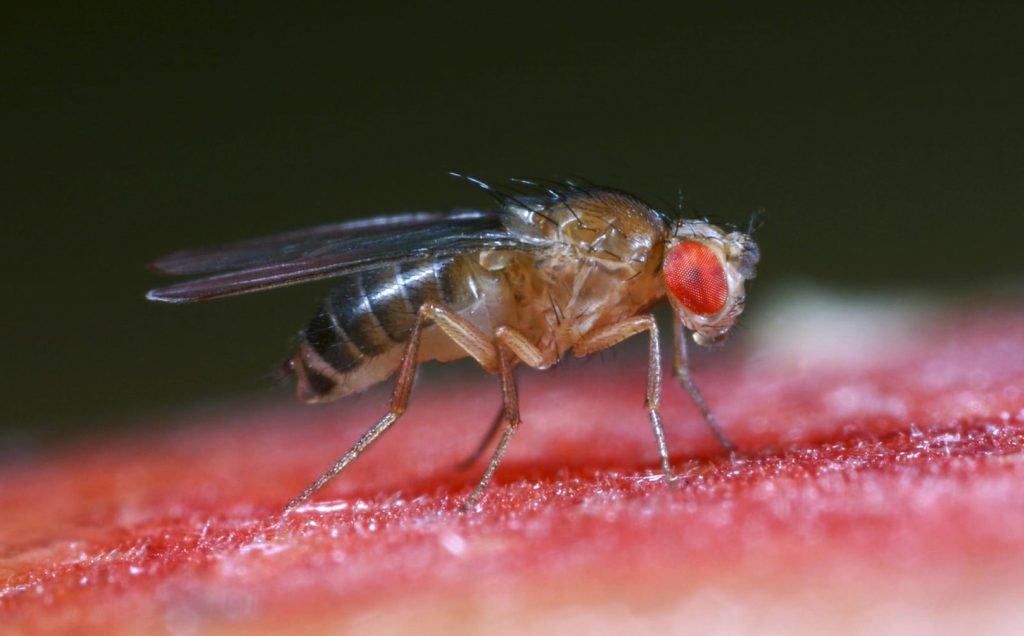
Fruit flies are minuscule brown house pests that particularly favor overripe, decaying fruit.
Fruit flies are tiny flying pests that are commonly found indoors during the summer months when fruits and vegetables start to decay. These small house flies typically measure between 0.078″ and 0.15″ (2 to 4 mm) in length. They have oval yellow-brown bodies, red compound eyes, and transparent wings. However, due to their small size, it can be challenging to discern their features.
You can usually identify fruit flies by their presence near fruit bowls, trash cans, or areas where sugary liquids have been spilled. As fruits become overripe and begin to spoil, the number of fruit flies tends to increase. They are sometimes referred to as vinegar flies because they are attracted to fermented liquids.
Fruit flies enter homes through open windows and small gaps. Even with fly screens in place, these tiny critters can often squeeze through the mesh.
Distinguishing fruit flies from other types of houseflies is relatively straightforward. They are typically the smallest flies found in homes. Although they may resemble fungus gnats, fruit flies tend to hover around decaying garbage and mushy fruit, while fungus gnats are more commonly found around houseplants.
While fruit flies do not bite, they can carry bacterial diseases and contaminate surfaces. Consuming food infested with these flies may lead to mild intestinal upset, nausea, and diarrhea.
Control of Fruit Flies
Preventing fruit flies from infesting your home involves storing food in airtight containers and promptly refrigerating it after purchase. Overripe fruits and rotting vegetables should be discarded in outdoor trash bins. Eliminating breeding sites is crucial for effective control.
One effective method for killing fruit flies, drain flies, and gnats is by using a vinegar trap. To create one, pour one cup of apple cider vinegar into a small bowl and add a small amount of liquid dish soap. Cover the bowl with plastic wrap and secure it with a rubber band. Next, poke small holes in the top using a toothpick.
The flies or gnats are attracted to the fermenting liquid and enter through the holes. Once they land on the vinegar, the soap in the liquid causes them to sink and drown.
Drain Flies (Psychodidae)
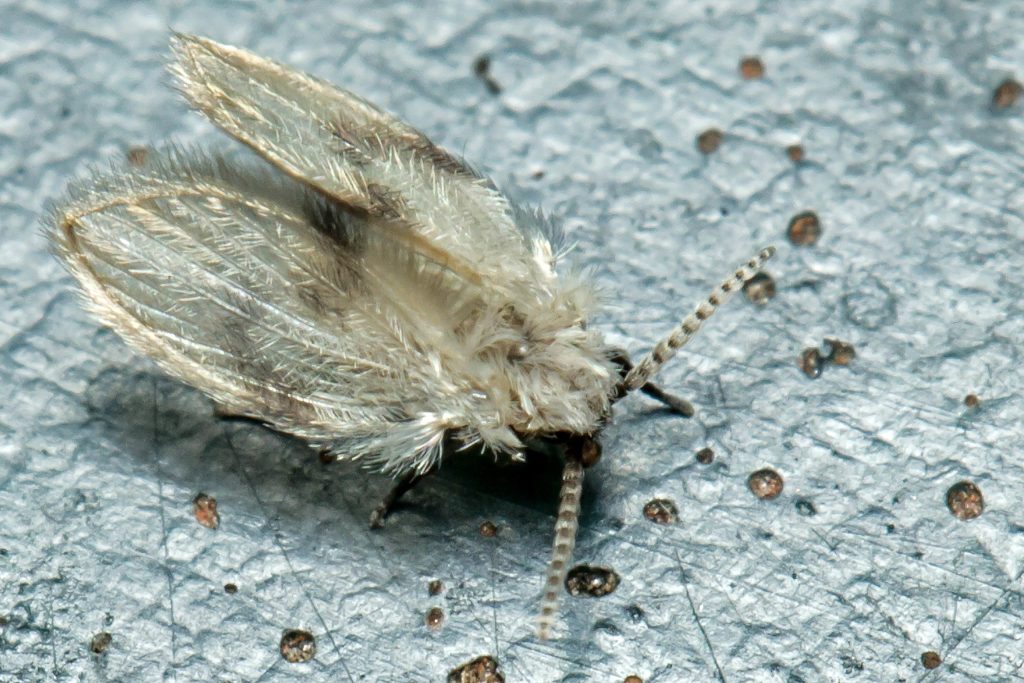
Drain flies are small, grayish-brown house flies with a furry appearance and are typically found near drainage systems.
Adult drain flies are tiny flies with grayish-brown bodies, hairy exteriors, and broad oval wings. These fuzzy flies, resembling small moths, are often found near drains in sinks, bathtubs, and other drainage systems. They measure between 0.078″ and 0.19″ (2 to 6 mm) in length.
Although you may observe them emerging from sink drains, drain flies do not enter homes through sewage or drainage systems. Instead, they gain entry through open windows and doors. The odor emanating from waste products attracts them to drains.
Female drain flies lay their eggs in drains, and within 48 hours, tiny larvae hatch from them. These larvae feed on bacteria and sludge within the pipes. However, these flies also lay eggs in stagnant water found under sinks, cracks between tiles, compost piles, or basement sinks.
Control of Drain Flies
Efficient control of drain flies involves removing all muck, sludge, and residue from drains, thereby eliminating their breeding grounds. Begin by unclogging all drains and thoroughly cleaning the U-trap beneath sinks and bathtubs.
You can also kill drain flies in your home by preparing a DIY solution using baking soda, salt, and vinegar. Mix
half a cup of table salt and half a cup of baking soda, then combine the dry ingredients with a cup of white vinegar in a bowl. Pour this mixture down the drain and leave it overnight. In the morning, pour boiling water down the drain to flush it.
Common Housefly (Musca domestica)
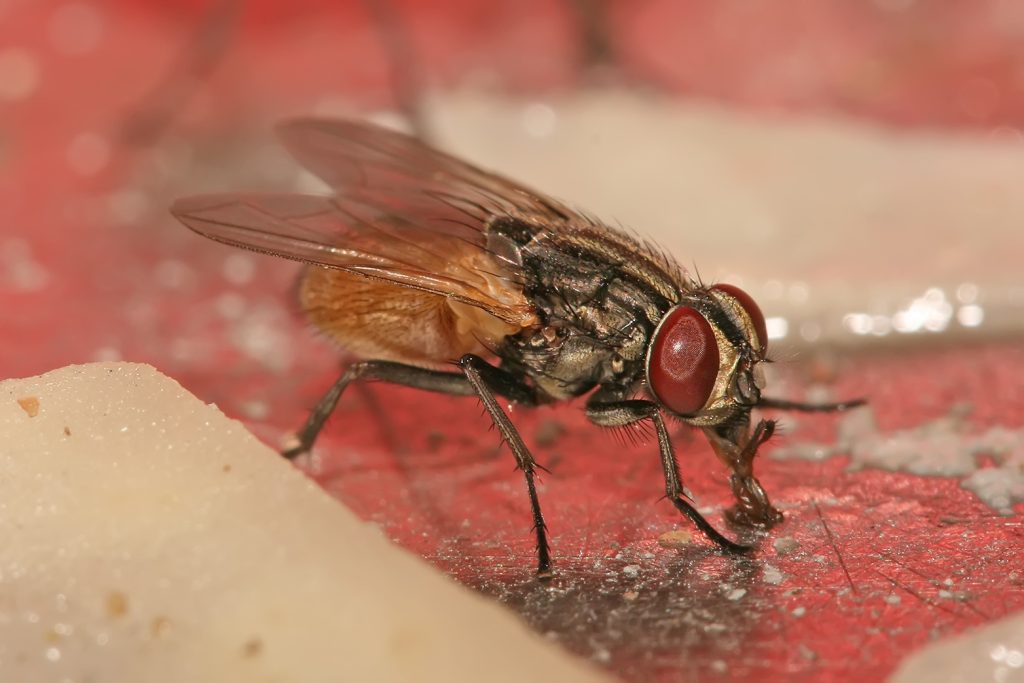
Common houseflies are prevalent small house pests that can cause infestations when present in large numbers.
The common housefly is a disease-carrying fly that occasionally finds its way into homes. These small flies have dark bodies with gray stripes, large reddish-brown compound eyes, and transparent wings. They typically become a problem indoors if there is a breeding site near the property.
Houseflies do not tend to breed indoors; instead, the females lay their eggs in compost heaps, garbage cans, food waste, feces, manure, or decaying organic matter. The eggs hatch into white, wriggling maggots after a day and transform into adult flies within two weeks.
Apart from being a nuisance due to their buzzing and erratic flying behavior, houseflies pose a risk as they regurgitate food on surfaces and deposit feces on food. They can transmit over 100 diseases, although they do not bite.
Distinguishing common houseflies from other indoor flies is relatively easy. They are larger than fruit flies, drain flies, and fungus gnats. Additionally, their flight patterns are more erratic, and they emit audible buzzing noises.
Control of Common Houseflies
The most effective way to get rid of common houseflies is by using a fly swatter. After killing a fly, it is essential to disinfect any surfaces it landed on to reduce the risk of bacterial transmission. If you notice an infestation of houseflies, you should inspect areas in your yard for potential breeding grounds.
Window and door screens are effective preventive measures to keep houseflies from entering your home. Additionally, store food in airtight containers or the refrigerator, and avoid leaving pet food out overnight, as it attracts flies, crawling pests, and vermin.
Fungus Gnats

Fungus gnats are small, black flying insects commonly found in damp areas inside the house or near houseplants.
Fungus gnats are slender black flies resembling mosquitoes. The tiny flies measure between 0.079″ and 0.30″ (2 to 8 mm) in length. They have cylindrical black bodies, a pair of wings, and six legs, although they are usually too small to be seen clearly with the naked eye.
The most effective way to identify fungus gnats is by observing their behavior. Females lay eggs in the top layer of moist potting soil. Once the larvae hatch, they feed on organic matter in the plant pots, eventually transforming into small flies. These black critters often crawl over plants but can also fly and are frequently seen hovering around them.
Fungus gnats do not bite humans and rarely cause damage to houseplants. However, large numbers of these flying pests can destroy seedlings.
Here are a few distinguishing characteristics between fungus gnats and fruit flies:
1. Fungus gnats are slender, while fruit flies are rounded and oval in shape.
2. Unlike fruit flies, fungus gnats are not attracted to overripe fruit; instead, they tend to stay near houseplants.
3. Fungus gnats are entirely black, whereas fruit flies have a dark brown color.
Control of Fungus Gnats
To eliminate fungus gnats living in the soil of houseplants, one effective method is to rinse the soil using a 3% hydrogen peroxide solution. Mix one part hydrogen peroxide with four parts water and pour the solution into the plant pot, thoroughly drenching the soil. This should be
sufficient to kill the eggs and larvae of the flies.
Proper watering techniques for houseplants can also help prevent fungus gnat infestations. Only water houseplants when the top 2″ (5 cm) layer of soil is dry to avoid providing favorable conditions for egg-laying.
In cases of large infestations, sticky traps can be used to reduce the number of fungus gnats.
Indianmeal Moth (Plodia interpunctella)

Indianmeal moths, also known as pantry moths, are small flying insects commonly found in kitchens and pantries, particularly in grain products.
These small, winged insects lay their eggs in stored grains and food, and the larvae hatch and begin feeding on these materials. Indianmeal moths typically measure between 0.3″ and 0.4″ (8 to 10 mm) in length.
Signs of an Indianmeal moth infestation are usually evident in stored dried food items. These kitchen bugs can infiltrate cereals, pasta, flour, rice, dried fruits, nuts, seeds, and spices. Additionally, you may notice silk-like webs, excrement (frass), or small white maggots, indicating their presence.
Control of Indianmeal Moths
To eradicate these pesky flying pantry bugs, it is crucial to dispose of any infested foods. Thoroughly clean kitchen cupboards and storage areas using hot soapy water. Always store dried food items in sealable plastic or glass containers as a preventive measure.
Lesser House Fly (Fannia canicularis)
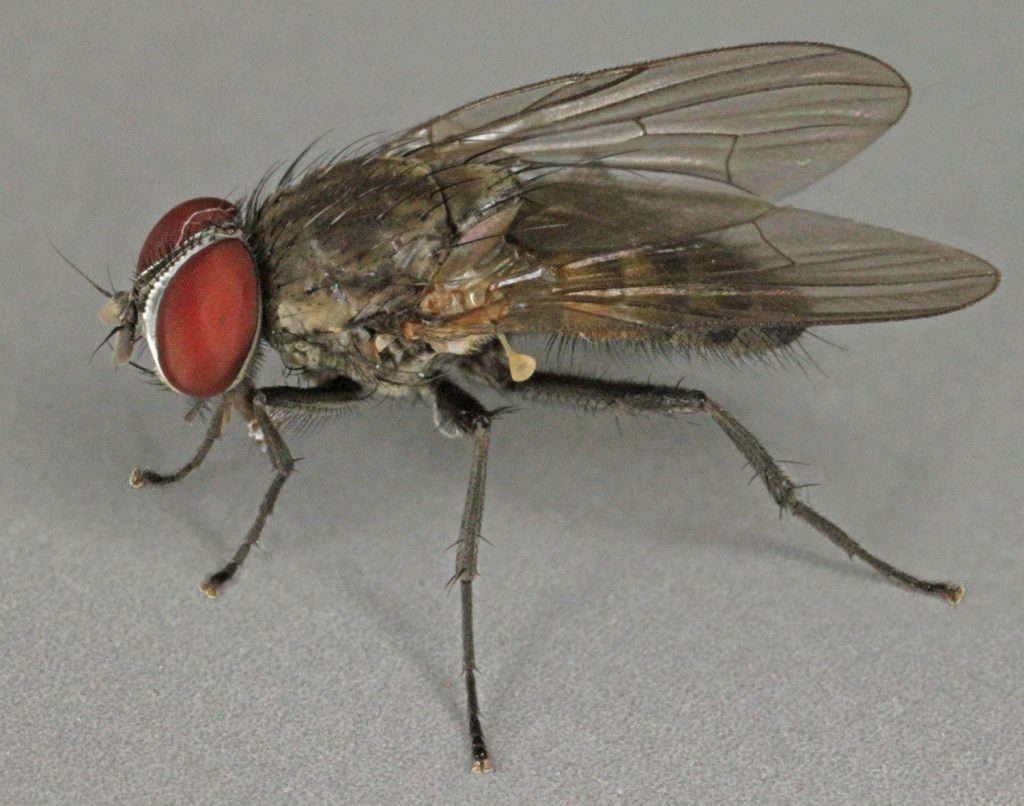
The lesser house fly resembles the common housefly but is smaller in size. These flies have brownish-gray bodies with black stripes and black legs. They possess large red compound eyes on their heads. Lesser house flies measure between 0.14″ and 0.24″ (3.5 to 6 mm) in length.
Keeping lesser house flies out of the house is crucial due to their ability to carry diseases. They lay eggs on feces and rotting organic matter, and their primary food source is garbage. When they land on surfaces, they can transmit diseases.
Blowflies (Calliphoridae)
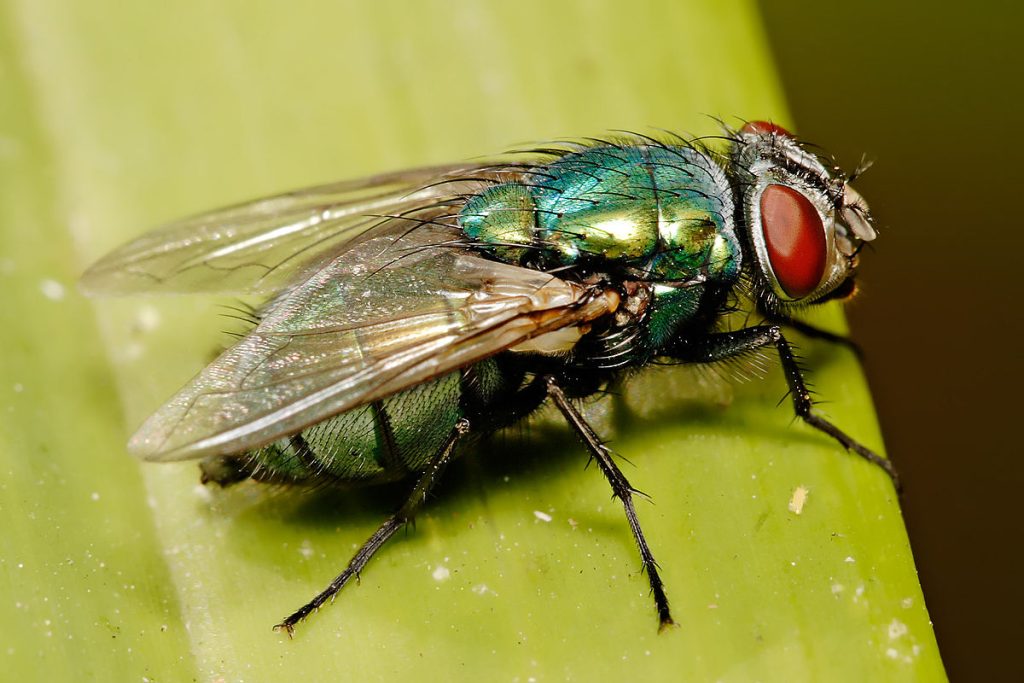
Blowflies, also known as bluebottles or greenbottles, are small flies characterized by their shiny metallic appearance. They are attracted to garbage and food.
Blowflies typically measure between 0.3″ and 0.4″ (8 to 10 mm) in length. These small flies can enter homes through open windows and are often found around garbage cans, pet food, or decomposing organic matter.
To prevent blowflies from entering your home, ensure that trash cans are closed tightly, and store fresh food and vegetables in the refrigerator.
Cluster Flies (Pollenia spp.)
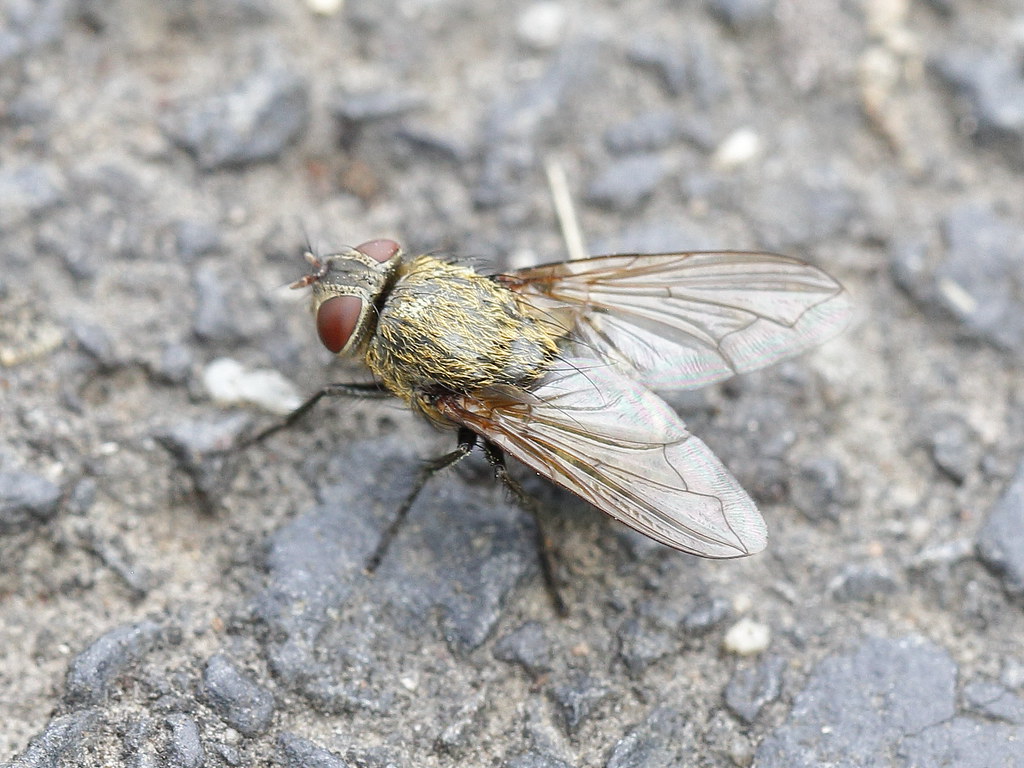
Cluster flies are harmless flies often found in dark, enclosed spaces. They are commonly known as attic flies due to their prevalence in attics. Cluster flies have gray abdomens with small black patches and brown compound eyes. They enter homes during cold weather and can reside in attics, basements, and similar locations.
Unlike common houseflies and blowflies, cluster flies do not transmit diseases as they do not lay eggs on human food. Therefore, these small grayish-black flies are not considered a nuisance pest in the house.
Phorid Flies (Phoridae)
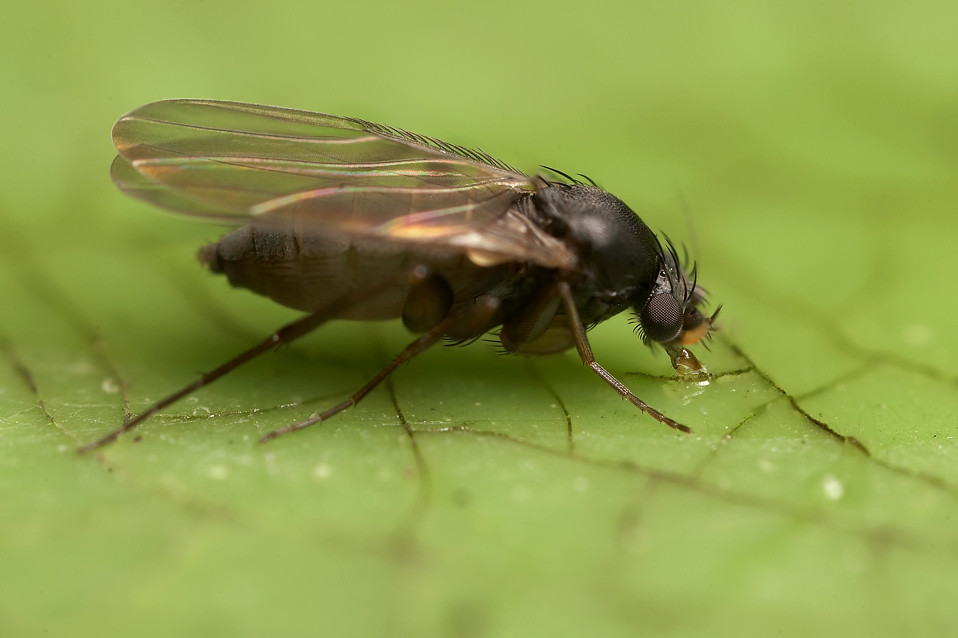
Phorid flies are tiny dark-brown or black flies measuring between 0.078″ and 0.15″ (2 to 4 mm). They have a distinct humpbacked appearance. These flies are often confused with drain flies or fruit flies because they inhabit unsanitary places such as garbage, drain pipes, moist plant soil, and decomposing organic matter.
To eliminate phorid flies, it is necessary to remove the sources of their breeding and feeding locations. Additionally, traps designed for fruit flies can be used to attract, capture, and kill phorid flies.
Flesh Flies (Sarcophagidae)
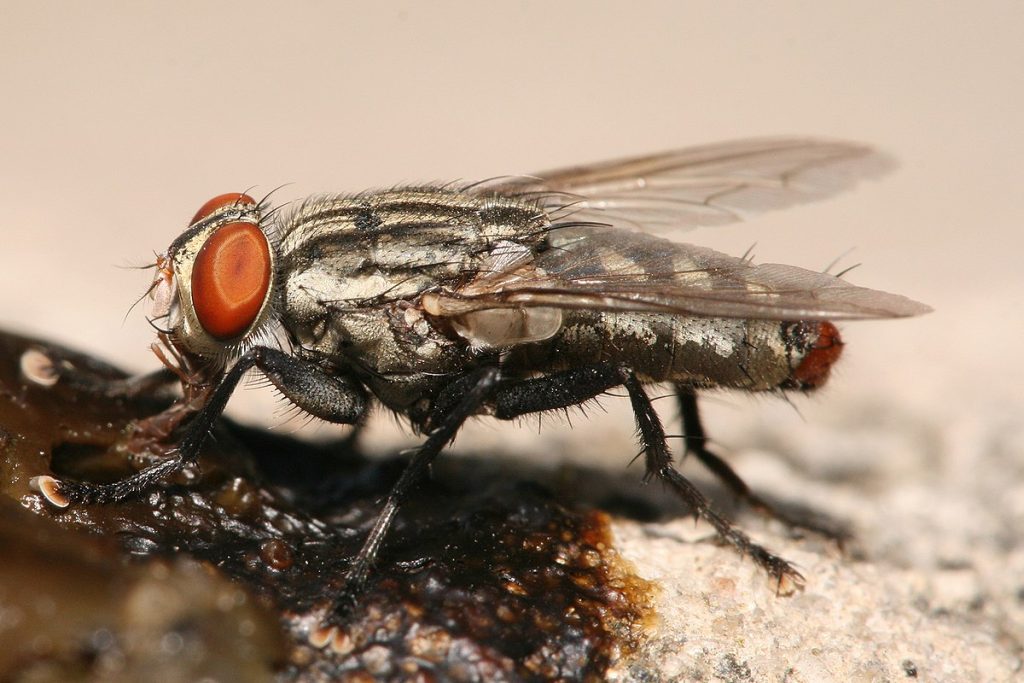
Flesh flies are medium-sized flies that can sometimes be found indoors. They have three black stripes on their thorax and mottled patterns on their abdomen. Flesh flies typically resemble large houseflies, measuring between 0.33″ and 0.5″ (8.5 to 12 mm) in length.
Flesh flies rarely infest homes as they usually live outdoors, feeding on decaying flesh. However, if you notice a significant number of flesh flies indoors, it is advisable to check for any dead animals or vermin around your home.
